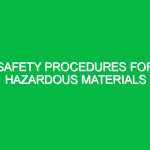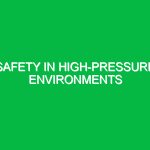Workplace safety is more than just a set of rules; it’s a culture that encompasses the collective responsibility of organizations and employees to create a safe working environment. Workplace Safety Best Practices are crucial for protecting employees, minimizing accidents, and ensuring regulatory compliance. In the realm of Health, Safety, and Environment (HSE), these practices form the backbone of a company’s operational integrity and its commitment to the well-being of its workforce.
Understanding Workplace Safety Best Practices
At its core, Workplace Safety Best Practices involve a series of protocols designed to mitigate risks and enhance safety in various environments—whether that’s in an office, on a construction site, or in a manufacturing facility. These practices are not just about compliance with laws and regulations; they are about fostering a culture of safety that empowers employees to take charge of their health and well-being.
For instance, consider a manufacturing plant where heavy machinery operates daily. An employee, Maria, observed that her colleague often bypassed safety guards on a machine to speed up their work. Maria decided to speak up, addressing her colleague with concern for their safety and the potential consequences of such actions. This incident not only highlights the importance of individual accountability but also underscores the need for continuous training and awareness regarding safety protocols. Such proactive behavior is integral to workplace safety best practices.
Identifying Hazards and Risks
Every workplace has its unique set of hazards and risks. Recognizing these dangers is the first step in implementing effective safety measures. Here are some common workplace hazards:
1. Physical Hazards
Physical hazards include anything that can cause harm due to environmental factors. This ranges from slippery floors to unguarded machinery. For example, in a warehouse, scattered pallets can lead to trip hazards, potentially causing serious injuries.
2. Chemical Hazards
Chemical hazards are present in workplaces that handle toxic substances. Exposure to harmful chemicals can lead to respiratory issues, skin irritations, or even long-term health complications. Industries such as pharmaceuticals and manufacturing often face significant risks in this area.
3. Biological Hazards
Biological hazards stem from exposure to harmful bacteria, viruses, or other microorganisms. Medical facilities, laboratories, and even offices can be susceptible, especially during flu seasons or pandemics.
4. Ergonomic Hazards
Ergonomic hazards arise from poorly designed workspaces that do not accommodate the physical needs of employees. Prolonged sitting, repetitive motions, and inadequate lifting techniques can lead to musculoskeletal disorders, affecting long-term health.
5. Psychosocial Hazards
Less tangible but equally dangerous, psychosocial hazards include stress, harassment, and workplace bullying. These factors can lead to mental health issues, reduced productivity, and increased absenteeism.
Best Practices for Workplace Safety
Implementing effective safety measures requires a comprehensive approach. Here are some actionable best practices to consider:
1. Conduct Regular Risk Assessments
Regularly assessing potential risks in the workplace is essential. This involves identifying hazards, evaluating the risks associated with them, and implementing control measures. A practical example is a construction site where daily safety inspections can uncover hazards before they lead to incidents.
2. Foster a Safety Culture
Creating a culture of safety means encouraging employees at all levels to prioritize safety. This can be achieved through open communication about safety issues, regular training sessions, and recognizing safe behaviors. For instance, a company might hold monthly safety meetings where employees are encouraged to share their experiences and suggestions for improvement.
3. Provide Comprehensive Training
Training is a cornerstone of workplace safety. Employees should receive thorough training on safety procedures, proper use of equipment, and emergency protocols. For example, in a laboratory setting, all personnel must be trained in handling hazardous materials safely, including understanding Material Safety Data Sheets (MSDS).
4. Implement Clear Safety Procedures
Clear, accessible safety procedures should be documented and made available to all employees. This includes everything from emergency exits to first aid protocols. Visibility is key; placing signs and labels around the workplace can serve as constant reminders of safety practices.
5. Encourage Reporting of Unsafe Conditions
Employees should feel empowered to report unsafe conditions without fear of retaliation. An anonymous reporting system can facilitate this, allowing for a more open dialogue about safety concerns. An example can be seen in many corporate environments where employees can submit safety issues through an internal app.
6. Invest in Safety Equipment
Providing the necessary safety equipment is crucial. This includes personal protective equipment (PPE) like helmets, gloves, and goggles, as well as safety barriers and proper ergonomics in workstations. For instance, in a manufacturing facility, having appropriate PPE readily available can significantly reduce the risk of injury.
7. Regularly Review and Update Policies
Workplace safety policies should not be static. Regular reviews ensure that they reflect current regulations and best practices. For example, after a significant incident, a company should analyze what went wrong and adjust their safety policies accordingly.
Regulations and Standards Governing Workplace Safety
Understanding the regulatory landscape is crucial for maintaining compliance and ensuring safety. Several key standards govern workplace safety:
1. Occupational Safety and Health Administration (OSHA)
In the United States, OSHA sets and enforces standards to ensure safe working conditions. Employers are required to follow guidelines that cover various aspects of workplace safety, from exposure limits to training requirements.
2. National Institute for Occupational Safety and Health (NIOSH)
NIOSH conducts research and makes recommendations to prevent work-related injuries and illnesses. Their findings often inform OSHA standards and provide crucial insights into emerging safety issues.
3. International Organization for Standardization (ISO)
ISO offers international standards that help organizations manage their safety and health risks. ISO 45001, for instance, is a standard for occupational health and safety management systems, providing a framework for improving employee safety, reducing workplace risks, and creating better working conditions.
Conclusion: The Path to Safer Workplaces
Workplace Safety Best Practices are not merely a set of guidelines; they represent a commitment to fostering a safe and healthy work environment. By identifying hazards, implementing effective safety measures, and adhering to regulatory standards, organizations can significantly reduce risks and enhance employee well-being. The importance of continuous training, open communication, and a proactive safety culture cannot be overstated. As we continue to navigate the complexities of modern workplaces, prioritizing safety is essential for not only compliance but for the overall success of any organization.
Ultimately, workplace safety is a shared responsibility. Each employee plays a vital role in maintaining a safe environment, and it is through collective effort that we can achieve the highest standards of health, safety, and environment (HSE). By adopting and championing Workplace Safety Best Practices, organizations can pave the way for a safer, healthier future for all.


